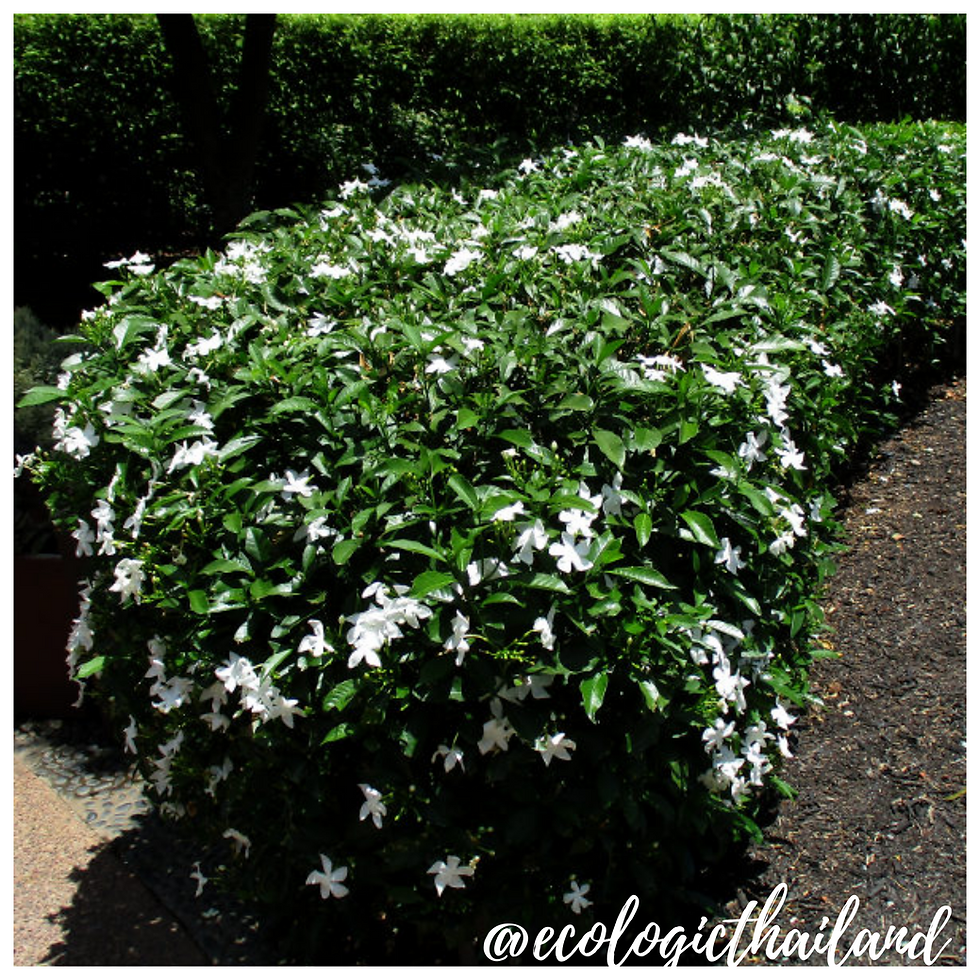Turmeric
- Eco-Logic Resort
- Jan 23, 2021
- 3 min read
Khamin | ขมิ้น | Curcuma longa
Family: Zingiberaceae - Genus: Curcuma

Turmeric is grown in the vegetable and in the herb gardens of the Thai Child Development Foundation.
Turmeric is a flowering plant of the ginger family, The roots are used in cooking. The plant is a perennial, rhizomatous, herbaceous plant native to Southeast Asia, that requires temperatures between 20 and 30 °C and a considerable amount of annual rainfall to thrive.
The flowers, leaves and roots of turmeric are edible. Turmeric is a superfood and is believed to have many medicinal benefits.
Turmeric can be harvested all year long, the flowering time is usually in August.

THE PLANT
Turmeric is a perennial herbaceous plant that reaches up to 1 meter tall.
Known for the yellow to orange, cylindrical, aromatic rhizomes .
Rhizomes, as well as flowers and leaves are edible.

THE LEAVES
Turmeric leaves are small to medium in size and are oblong or lanceolate in shape, averaging 80-115 centimeters in length and 30-48 centimeters in width. The smooth, light green leaves sprout from an erect, thick green stem that is connected to a golden root.
Turmeric leaves have a neutral aroma when fresh and once they are cut, pounded, or chewed, they release a distinctive tart flavor with notes of grass and mint.
When cooked, Turmeric leaves impart a floral, pungent, and gingery flavor with slightly bitter undertones.
The fragrant leaves are also used to wrap foods and the shoots are eaten as a vegetable.

THE FLOWERS
Turmeric flowers refer to the blooms of the Turmeric plant. The funnel-shaped flowers are white, yellow or pink. They bloom between pale green, leafy bracts, or modified leaves, of the plant. The entire floral structure is conical in shape, and is around 12 centimeters in length. Both the flowers and vegetative bracts are edible, and have a pungent fragrance.
They have a delicate texture and taste. They have faint notes of the piquant spiciness that one associates with the Turmeric root.
Turmeric flowers are considered to be a rare item, as the Turmeric plant does not blossom frequently.

THE RHIZOMES
Turmeric rhizomes (underground stems) are the source of a bright yellow-orange culinary spice (the main ingredient of curry powder) and as a dye.
The rhizomes can be boiled in water, dried, peeled and then ground. Turmeric is added to many disheS. They are also used as bright yellow dye for textiles and paints.
CULINARY USES
Turmeric root is frequently used in Thai curries and other savory dishes. Yellow curries get their color from turmeric. Thai yellow curry paste is made with turmeric and used in recipes for meat, seafood, vegetables, noodles, and soups.
Turmeric leaves are commonly used in curries, soups, chutneys, or prepared pickled. They are also used as a wrapper for steamed dishes.
Thai cuisine also feature dishes that are steamed in Turmeric leaf parcels as the heat intensifies the flavor of the leaf which imparts flavor to the dish.
Turmeric leaves can also be ground or crushed to make a paste and then fried to be used in dishes such as beef or chicken rendang which is a dry curry meat dish.
Turmeric leaves pair well with lemongrass, kaffir lime leaves, tamarind, chilies, garlic, onion, ginger, and coconut milk.
Turmeric flowers are edible too. They have a delicate texture and taste. They have faint notes of the piquant spiciness that one associates with the Turmeric root.
NUTRITION
100 g of turmeric provides 53% of dietary fiber, vitamin B-6 (pyridoxine), niacin, vitamin C, vitamin E, potassium, iron, manganese, zinc and 0% cholesterol.
TRADITIONAL MEDICINAL USE OF NEEDLE FLOWER
NOTE: please take advice from a doctor if you are planning to use herbal medicine.
Turmeric powder might well be the healthiest spice on Earth. Made by grinding the dried root of the Curcuma longa plant, this ancient superfood and key ingredient in curry powder has been used by Ayurvedic healers for centuries.
Turmeric and especially its most active compound curcumin have many scientifically-proven health benefits, such as the potential to prevent heart disease, Alzheimer’s and cancer.
It’s a potent anti-inflammatory and antioxidant and may also help improve symptoms of depression and arthritis.
Just a few grams of turmeric per day either in the form of powder, crushed root or fresh root can provide enough nutrients to help you keep away from anemia, neuritis, memory disorders and offer protection against cancers, infectious diseases, high blood pressure, and strokes.
It has anti-inflammatory and disinfecting properties. This explains its healing powers when applied to cuts and abrasions.
INTO THE WILD: a down to earth experience

For guests and visitors to Paksong we organize weekly tours "The Edible Forest" and Foraging weekends: Into the Wild. We work with local guides to take you in the jungle of Paksong. After foraging, we will cook a meal with the ingredients, using bamboo together with you!
Come and join and learn about the abundance of food that nature gives us!
INTO THE WILD!


















Comments